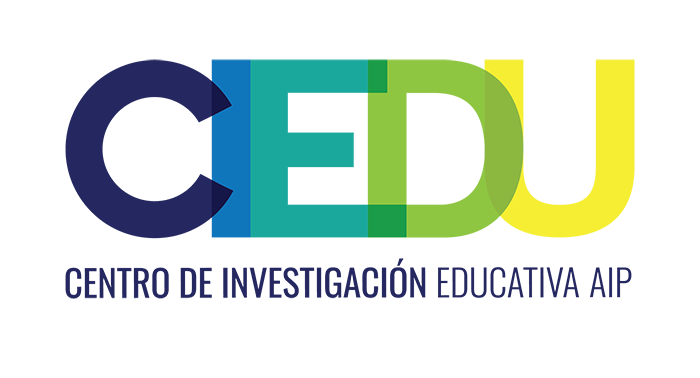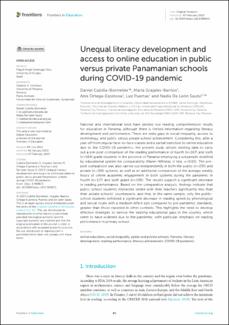| dc.contributor.author | Daniel Cubilla-Bonnetier; María Grajales-Barrios; Anis Ortega-Espinosa; Luz Puertas; Nadia De León Sautú | |
| dc.date.accessioned | 2023-04-03T19:00:45Z | |
| dc.date.available | 2023-04-03T19:00:45Z | |
| dc.date.issued | 2023-02-07 | |
| dc.identifier.citation | Cubilla-Bonnetier D, Grajales-Barrios M, Ortega-Espinosa A, Puertas L and De León Sautú N (2023) Unequal literacy development and access to online education in public versus private Panamanian schools during COVID-19 pandemic. Front. Educ. 8:989872. doi: 10.3389/feduc.2023.989872 | en_US |
| dc.identifier.uri | https://repositorio.ciedupanama.org/handle/123456789/279 | |
| dc.description | National and international tests have yielded low reading comprehension results for education in Panama, although there is limited information regarding literacy development and performance. There are wide gaps in social inequality, access to technology, and public versus private school achievement. Considering this, after a year off from regular face-to-face classes and a partial transition to online education due to the COVID-19 pandemic, the present study utilizes existing data to carry
out a pre-post comparison of the reading performance of fourth (n = 167) and sixth (n = 164) grade students in the province of Panama employing a subsample stratified by educational system for comparability (Mann–Whitney U test, α = 0.05). The prepost comparison was also carried out independently in both the public (n = 235) and private (n = 106) systems, as well as an additional comparison of the average weekly hours of online academic engagement in both systems during the pandemic in fourth (n = 117) and sixth grade (n = 109). The results support a significant decrease in reading performance. Based on the comparative analysis, findings indicate that public school students interacted online with their teachers significantly less than their private schools’ counterparts; and that, in the same sample, only the publicschool students exhibited a significant decrease in reading speed by phonological and lexical route with a medium effect size compared to pre-pandemic standards, greater than those reported in other contexts. This highlights the need to develop effective strategies to narrow the existing educational gaps in the country, which seem to have widened due to the pandemic, with particular emphasis on reading performance in primary school. | en |
| dc.description.abstract | National and international tests have yielded low reading comprehension results for education in Panama, although there is limited information regarding literacy development and performance. There are wide gaps in social inequality, access to technology, and public versus private school achievement. Considering this, after a year off from regular face-to-face classes and a partial transition to online education due to the COVID-19 pandemic, the present study utilizes existing data to carry
out a pre-post comparison of the reading performance of fourth (n = 167) and sixth (n = 164) grade students in the province of Panama employing a subsample stratified by educational system for comparability (Mann–Whitney U test, α = 0.05). The prepost comparison was also carried out independently in both the public (n = 235) and private (n = 106) systems, as well as an additional comparison of the average weekly hours of online academic engagement in both systems during the pandemic in fourth (n = 117) and sixth grade (n = 109). The results support a significant decrease in reading performance. Based on the comparative analysis, findings indicate that public school students interacted online with their teachers significantly less than their private schools’ counterparts; and that, in the same sample, only the publicschool students exhibited a significant decrease in reading speed by phonological and lexical route with a medium effect size compared to pre-pandemic standards, greater than those reported in other contexts. This highlights the need to develop effective strategies to narrow the existing educational gaps in the country, which seem to have widened due to the pandemic, with particular emphasis on reading performance in primary school. | en |
| dc.format | application/pdf | en |
| dc.language.iso | en | en |
| dc.language.iso | en_US | en_US |
| dc.publisher | Frontiers in Education | en_US |
| dc.relation.ispartofseries | Digital Education;Volume 8 - 2023 | |
| dc.rights | info:eu-repo/semantics/openAccess | en |
| dc.rights | https://creativecommons.org/licenses/by-nc-nd/4.0 | en |
| dc.subject | online education, social inequality, public and private schools, Panama, literacy development, reading performance, literacy achievement, COVID-19 pandemic | en_US |
| dc.subject | online education, social inequality, public and private schools, Panama, literacy development, reading performance, literacy achievement, COVID-19 pandemic | en |
| dc.title | Unequal Literacy Development And Access To Online Education In Public Versus Private Panamanian Schools During Covid-19 Pandemic | en |
| dc.type | info:eu-repo/semantics/article | en_US |
| dc.type | info:eu-repo/semantics/publishedVersion | en_US |
| dc.type | info:eu-repo/semantics/article | en |
| dc.type | info:eu-repo/semantics/publishedVersion | en |

